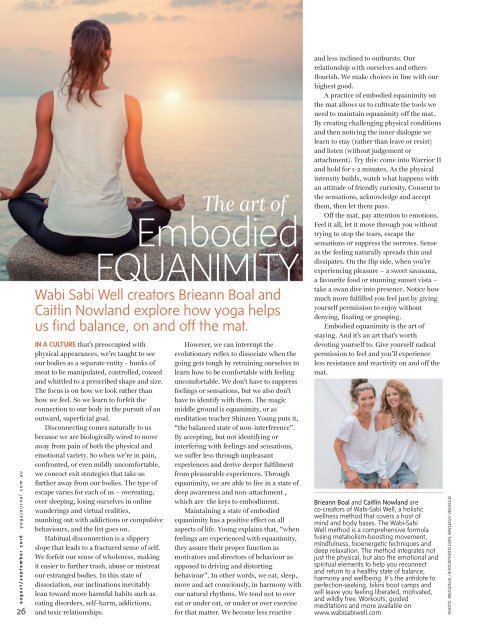Australian_Yoga_Journal_2016_08_09_downmagaz.com
You also want an ePaper? Increase the reach of your titles
YUMPU automatically turns print PDFs into web optimized ePapers that Google loves.
august/september <strong>2016</strong> yogajournal.<strong>com</strong>.au<br />
26<br />
The art of<br />
Embodied<br />
EQUANIMITY<br />
Wabi Sabi Well creators Brieann Boal and<br />
Caitlin Nowland explore how yoga helps<br />
us find balance, on and off the mat.<br />
IN A CULTURE that’s preoccupied with<br />
physical appearances, we’re taught to see<br />
our bodies as a separate entity - hunks of<br />
meat to be manipulated, controlled, coaxed<br />
and whittled to a prescribed shape and size.<br />
The focus is on how we look rather than<br />
how we feel. So we learn to forfeit the<br />
connection to our body in the pursuit of an<br />
outward, superficial goal.<br />
Disconnecting <strong>com</strong>es naturally to us<br />
because we are biologically wired to move<br />
away from pain of both the physical and<br />
emotional variety. So when we’re in pain,<br />
confronted, or even mildly un<strong>com</strong>fortable,<br />
we concoct exit strategies that take us<br />
further away from our bodies. The type of<br />
escape varies for each of us – overeating,<br />
over sleeping, losing ourselves in online<br />
wanderings and virtual realities,<br />
numbing out with addictions or <strong>com</strong>pulsive<br />
behaviours, and the list goes on.<br />
Habitual disconnection is a slippery<br />
slope that leads to a fractured sense of self.<br />
We forfeit our sense of wholeness, making<br />
it easier to further trash, abuse or mistreat<br />
our estranged bodies. In this state of<br />
dissociation, our inclinations inevitably<br />
lean toward more harmful habits such as<br />
eating disorders, self-harm, addictions,<br />
and toxic relationships.<br />
However, we can interrupt the<br />
evolutionary reflex to dissociate when the<br />
going gets tough by retraining ourselves to<br />
learn how to be <strong>com</strong>fortable with feeling<br />
un<strong>com</strong>fortable. We don’t have to suppress<br />
feelings or sensations, but we also don’t<br />
have to identify with them. The magic<br />
middle ground is equanimity, or as<br />
meditation teacher Shinzen Young puts it,<br />
“the balanced state of non-interference”.<br />
By accepting, but not identifying or<br />
interfering with feelings and sensations,<br />
we suffer less through unpleasant<br />
experiences and derive deeper fulfilment<br />
from pleasurable experiences. Through<br />
equanimity, we are able to live in a state of<br />
deep awareness and non-attachment ,<br />
which are the keys to embodiment.<br />
Maintaining a state of embodied<br />
equanimity has a positive effect on all<br />
aspects of life. Young explains that, “when<br />
feelings are experienced with equanimity,<br />
they assure their proper function as<br />
motivators and directors of behaviour as<br />
opposed to driving and distorting<br />
behaviour”. In other words, we eat, sleep,<br />
move and act consciously, in harmony with<br />
our natural rhythms. We tend not to over<br />
eat or under eat, or under or over exercise<br />
for that matter. We be<strong>com</strong>e less reactive<br />
and less inclined to outbursts. Our<br />
relationship with ourselves and others<br />
flourish. We make choices in line with our<br />
highest good.<br />
A practice of embodied equanimity on<br />
the mat allows us to cultivate the tools we<br />
need to maintain equanimity off the mat.<br />
By creating challenging physical conditions<br />
and then noticing the inner dialogue we<br />
learn to stay (rather than leave or resist)<br />
and listen (without judgement or<br />
attachment). Try this: <strong>com</strong>e into Warrior II<br />
and hold for 1-2 minutes. As the physical<br />
intensity builds, watch what happens with<br />
an attitude of friendly curiosity. Consent to<br />
the sensations, acknowledge and accept<br />
them, then let them pass.<br />
Off the mat, pay attention to emotions.<br />
Feel it all, let it move through you without<br />
trying to stop the tears, escape the<br />
sensations or suppress the sorrows. Sense<br />
as the feeling naturally spreads thin and<br />
dissipates. On the flip side, when you’re<br />
experiencing pleasure – a sweet savasana,<br />
a favourite food or stunning sunset vista –<br />
take a swan dive into presence. Notice how<br />
much more fulfilled you feel just by giving<br />
yourself permission to enjoy without<br />
denying, fixating or grasping.<br />
Embodied equanimity is the art of<br />
staying. And it’s an art that’s worth<br />
devoting yourself to. Give yourself radical<br />
permission to feel and you’ll experience<br />
less resistance and reactivity on and off the<br />
mat.<br />
Brieann Boal and Caitlin Nowland are<br />
co-creators of Wabi-Sabi Well, a holistic<br />
wellness method that covers a host of<br />
mind and body bases. The Wabi-Sabi<br />
Well method is a <strong>com</strong>prehensive formula<br />
fusing metabolism-boosting movement,<br />
mindfulness, bioenergetic techniques and<br />
deep relaxation. The method integrates not<br />
just the physical, but also the emotional and<br />
spiritual elements to help you reconnect<br />
and return to a healthy state of balance,<br />
harmony and wellbeing. It’s the antidote to<br />
perfection-seeking, bikini boot camps and<br />
will leave you feeling liberated, motivated,<br />
and wildly free. Workouts, guided<br />
meditations and more available on<br />
www.wabisabiwell.<strong>com</strong><br />
PHOTO: BRUSONJA /ISTOCKPHOTO.COM; BAYLEIGH VEDALGO


